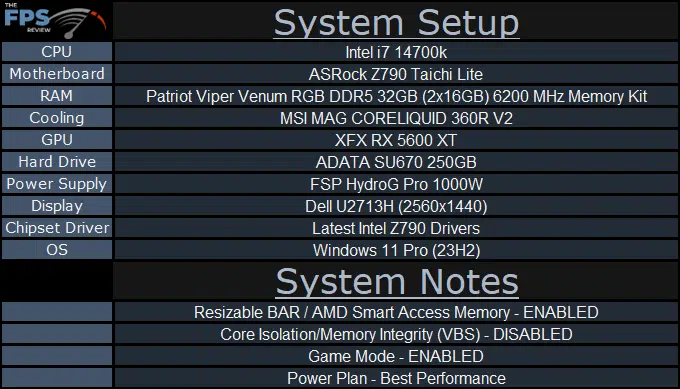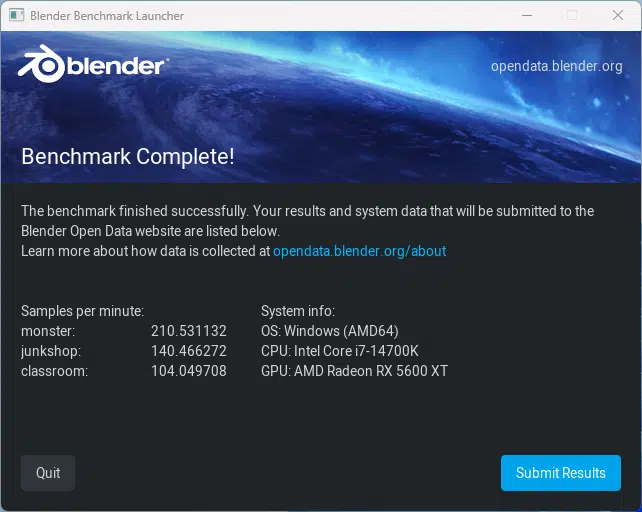
Introduction
Today we have the new ASRock Z790 Taichi Lite in the house to put through our testing and see how it holds up. Currently, this motherboard is $349 on NewEgg, putting this more in the higher-end motherboard category from our point of view. We will be loading this motherboard up with the i7 14700k that we recently reviewed, if you have the time you should also check out the i9 14900K and i5 14600k reviews we have as well.
The ASRock Z790 Taichi Lite is based on Intel’s Z790 chipset that was introduced alongside the 13th-generation desktop processors. With this chipset you can expect support for 20 lanes of PCIe 4.0, 8 of PCIe 3.0, and a plethora of USB 3.2 (Both Type A and C) ports. Notably however with the Z790 chipset is that PCIe 5.0 is handled exclusively by the processor and not the chipset which will lead to performance limitations if you plan on utilizing a Gen5 M.2 drive in the topmost slot.
Packaging and Contents
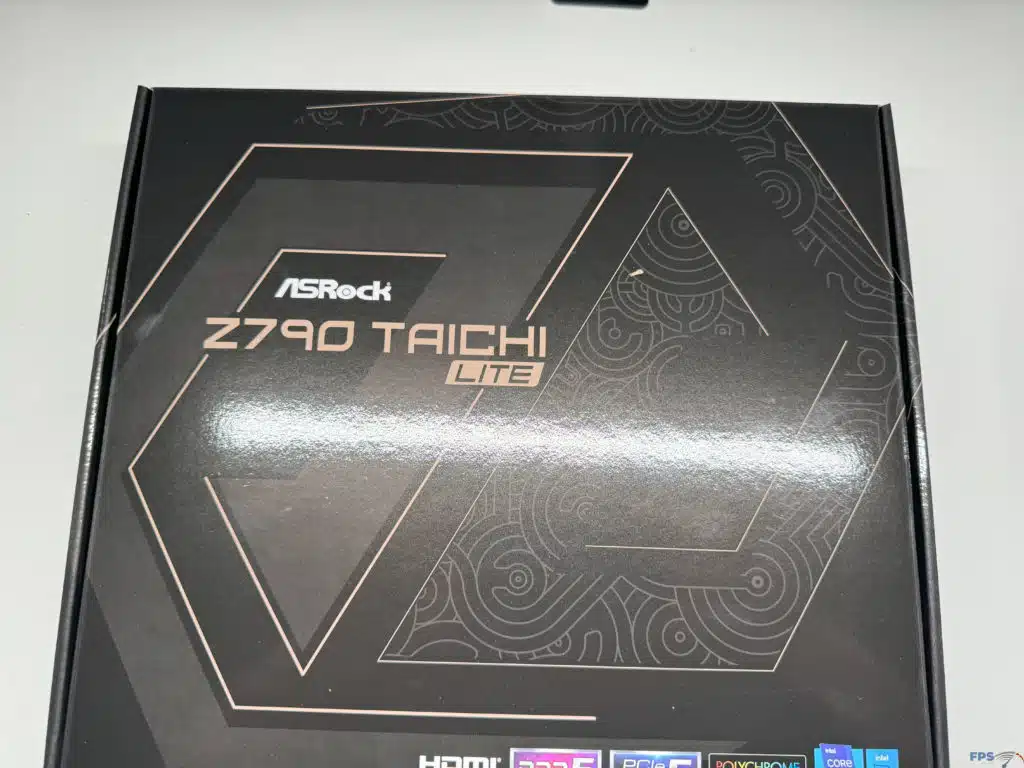
The ASRock Z790 Taichi Lite comes in at the lower end of the “high-range” Z790 motherboards, and the contents you receive with this motherboard show that. Inside of the box, you will find four (4) SATA cables, a WiFi antenna with base, a USB expansion bracket, four (4) M.2 socket screws, the typical user manual, some wire management Velcro, a Taichi branded start key for your keyboard, and a small pamphlet.

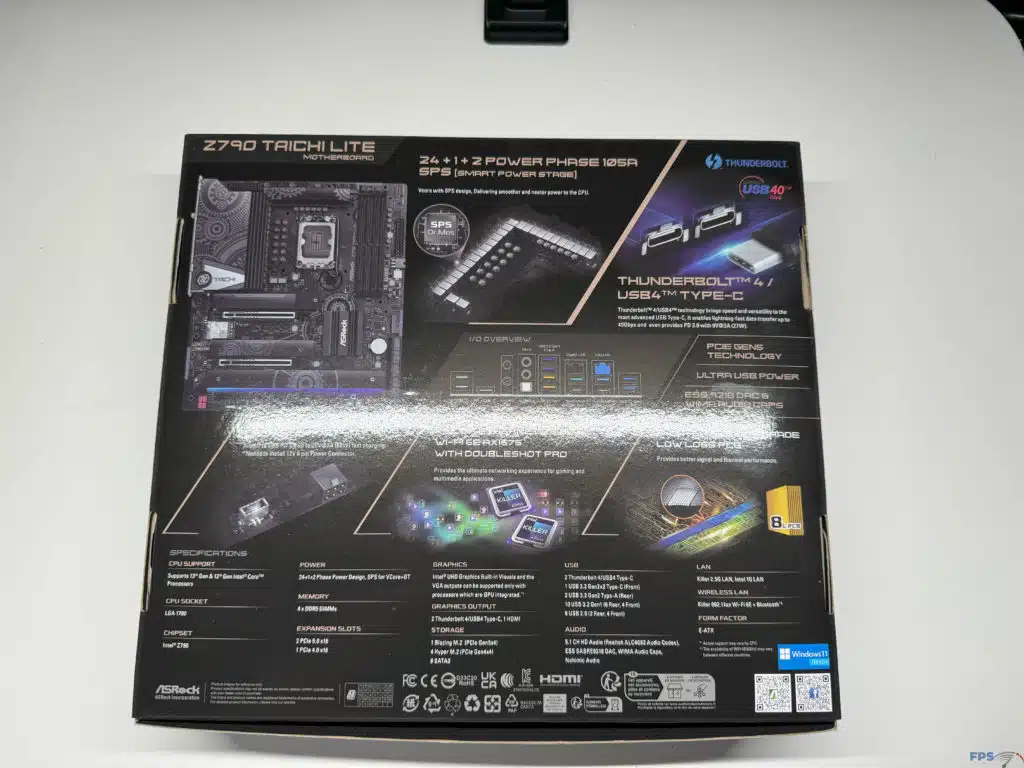
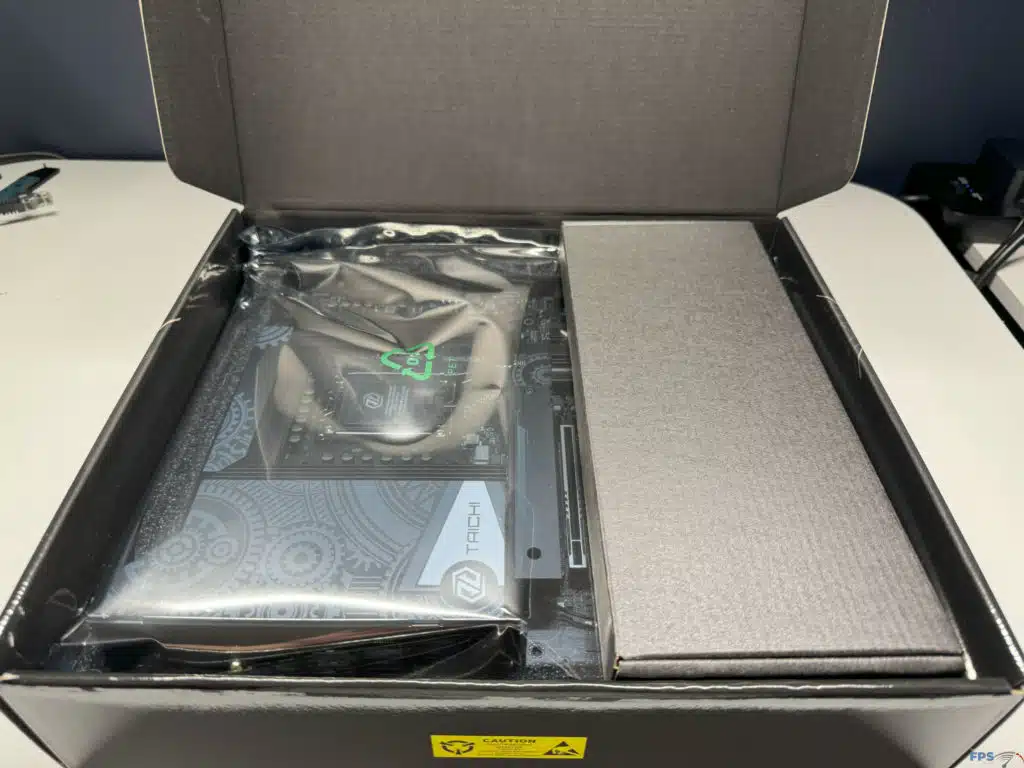
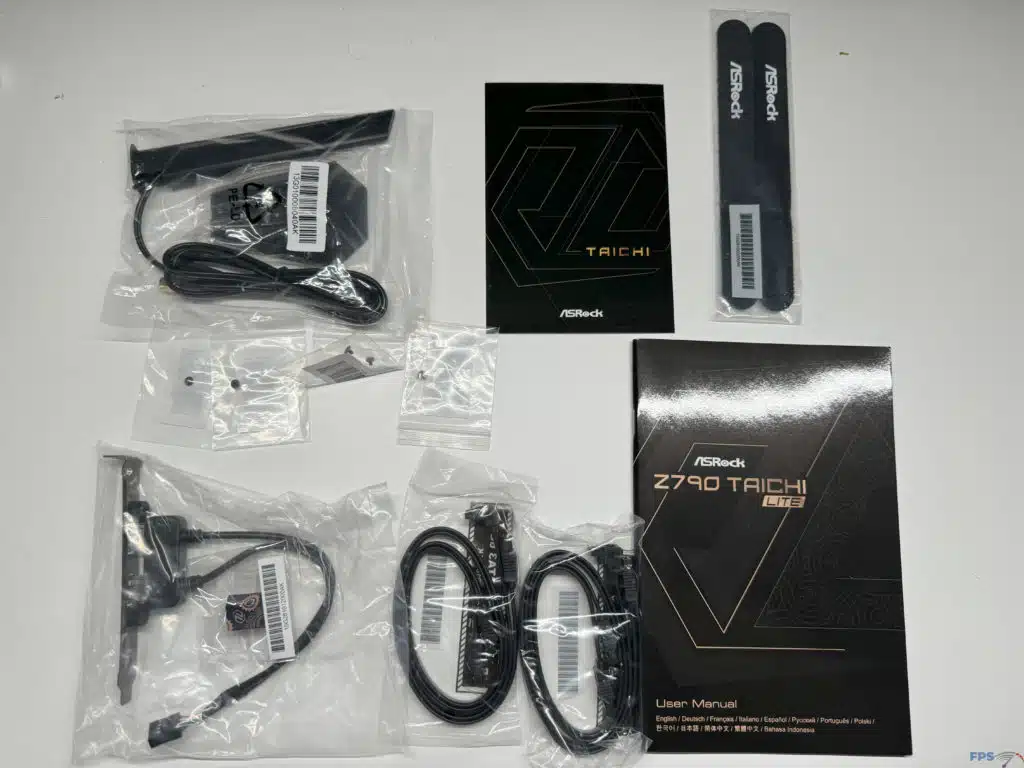
ASRock Z790 Taichi Lite PCB & Features
The first thing that stands out when you look at this motherboard is that it is in the EATX form factor so make sure that your case will be able to fit it. Outside of that, the layout and features are what you would expect from a motherboard in this price range. There are plenty of heat spreaders, from every M.2. slot intended for an SSD, to the south bridge, to the 24+1+2 MOSFET design and their cooling, to the chipset cooler itself. It is nice to see a heat spreader provided by the manufacturer for all of the slots, it is important to note that all of these will require a small Phillips screwdriver to remove, and only the topmost cooler provides substantial mass for heat dissipation. Additionally, this motherboard has one more feature that is nice to have, with both of the primary PCIe slots being steel-reinforced.
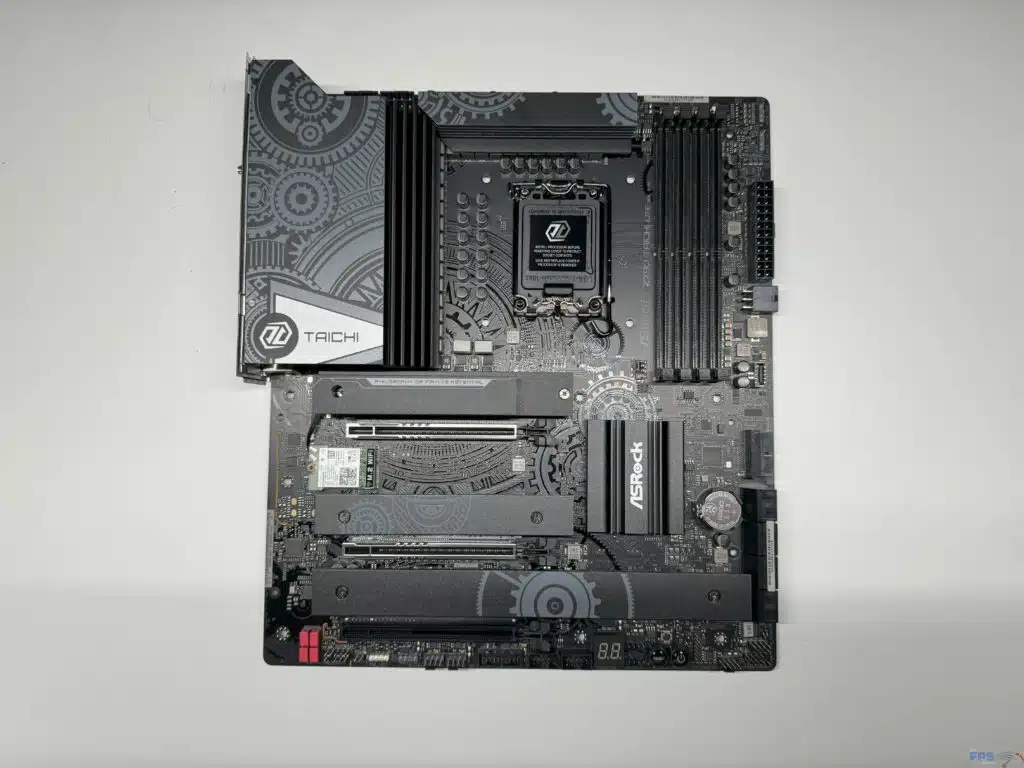
On this motherboard we see ASRock going with a 24+1+2 VRM power delivery design utilizing the DrMOS Smart Power Stage technology that we often see on ASRock motherboards. The VRMs have an extra-large aluminum heat sink for aided performance. This along with the 8-layer PCB, and the overall solid feel of construction for this motherboard will allow you to push your new 14th-generation Intel processor to the limits.
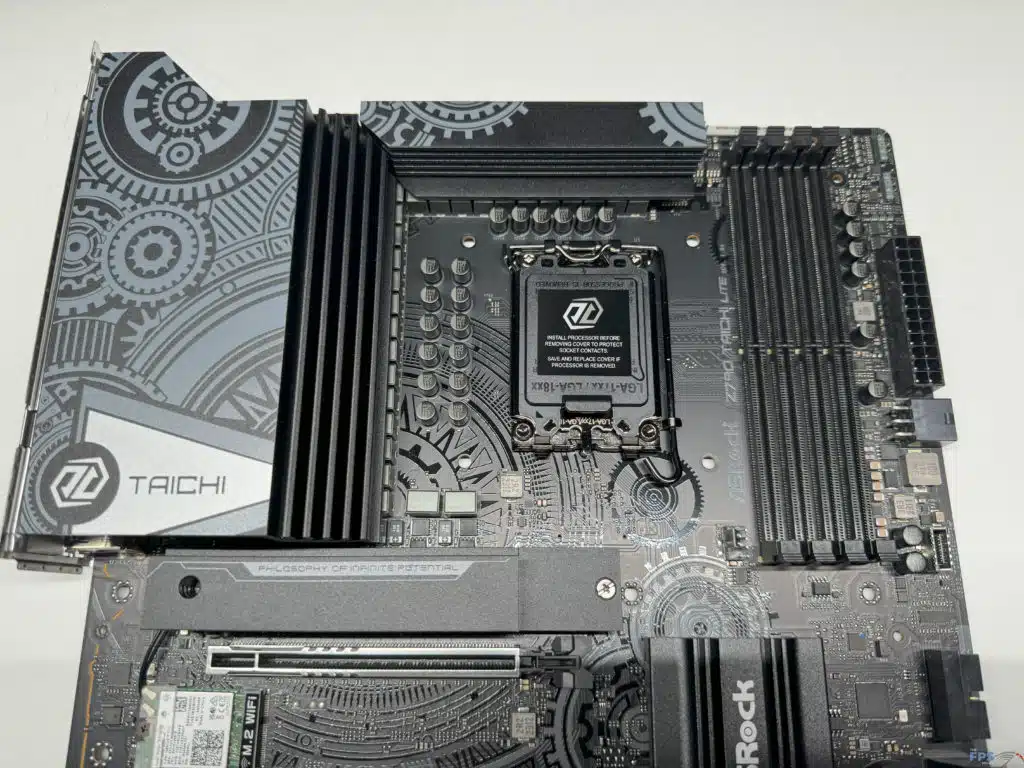
For the rear I/O connections we have two network connections, a 2.5 GbE Killer E3100G and a standard port powered by an Intel I219V, two (2) antenna ports, two (2) USB 4.0 Thunderbolt Type-C ports, four (4) USB 3.2 Gen1 Type-A Ports, two (2) USB 3.2 Gen2 Type-A Ports, two (2) USB 2.0 ports, an HDMI port, a Microphone in, Line Out, and a SPDIF optical out port. One thing to note is that two of the USB 3.2 Gen1 ports are the ASRock Lightning Gaming ports which ASRock purposefully pulls from two different controller interfaces to limit the amount of traffic your devices might interfere with. This motherboard also has an additional 12V 6-pint power connector to enable fast charging on the USB-3 ports by providing PD 3.0 speeds (Up to 60W with 20V@3Amps).
On the storage front for the ASRock Z790 Taichi Lite we have a total of eight (8) SATA 6GB/s connectors from the chipset, one (1) M.2 Gen5 slot from the CPU, one (1) M.2 Gen4 slot from the CPU, and three (3) Gen4 slots from the chipset. One oddity you will see on this motherboard is that two of the M.2 slots, M2_1 and M2_2, are provided via the CPU. Even more interesting is that only one of these slots can physically be used at a single time (due to them being directly opposite of each other above the top PCIe slot). This is to allow you to utilize the direct lanes to the CPU with either Gen4 or Gen5 speeds, however be warned that using a Gen5 drive (Slot M2_1), will require you taking a performance hit on your Gen5 PCIe slot. There is one additional M.2 slot, and while it is exposed, it is intended to be utilized for the WiFi / Bluetooth adapter.
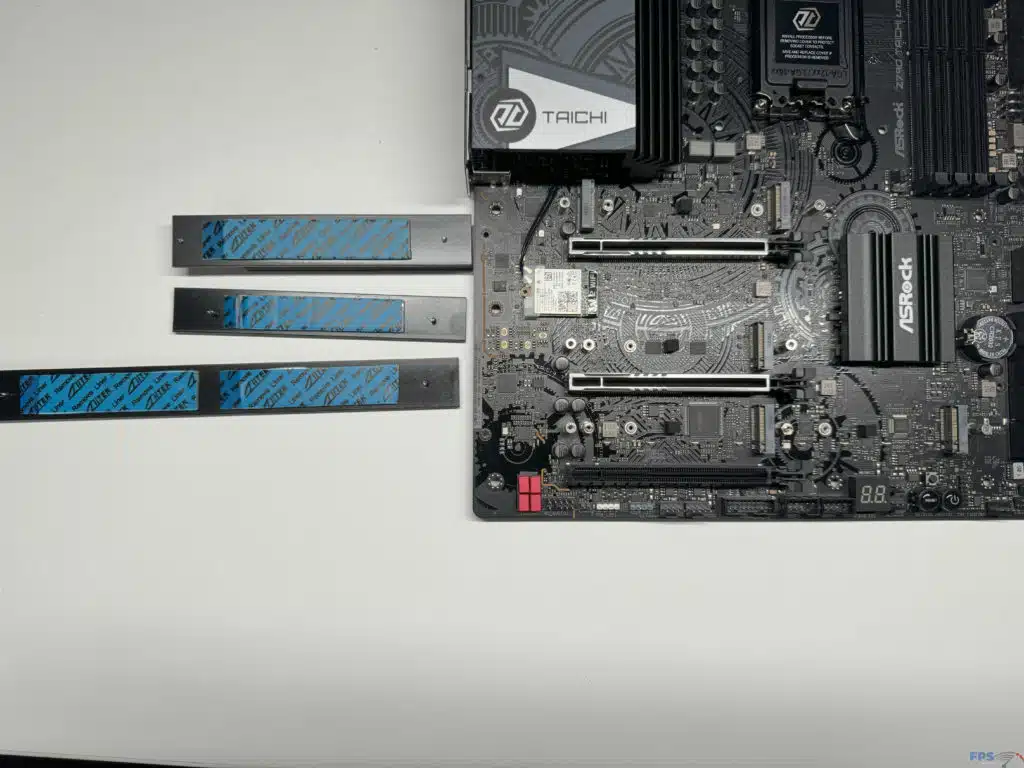
Expansion slots on this motherboard are from three (3) PCIe slots, the top two slots are PCIe 5.0 slots from the CPU (Providing either single at x16, or both at x8/x8), and a PCIe 4.0×16 slot from the chipset.
As is the case with all motherboards on the consumer market today, there are additional connectivity options in the form of internal USB headers. All of the onboard headers are powered by the Z790 chipset, and you have the ability to add an additional USBC Type 3.2 (Gen 2×2) port, four (4) USB 3.2 Gen1 ports (Through two headers), and four (4) USB 2.0 ports (Through two headers).
For fan headers, you have a total of eight (8) total 4-pin type connectors. One (1) is dedicated for a CPU fan, an additional one is dedicated to either a second CPU fan or a water pump fan, and the remaining six (6) are available for additional fans or water pump connections. As always for testing we set all fans and pumps to 100% to maximize the cooling available to the CPU.
While RGBs are definitely a thing you either love or hate, this motherboard has it in spades. You have a single RGB LED Header for connecting a 36W LED strip, or three (3) additional Addressable LED headers allowing up to 15W per strip. On top of this, there are some LEDs located beneath the lowest M.2 heat spreader, which are muted in color so long as the cover is on the drives. As always with ASRock, all of the RGB’s can be controlled either within Windows using the ASRock software, or from within the BIOS itself.
When you are looking to purchase memory for this motherboard it is important to remember that it only supports non-ECC, un-buffered DDR5 memory, and officially up to 7200+ MHz speeds when overclocking. This motherboard also allows for simple overclocking of your memory with the Extreme Memory Profile (XMP) 3.0 system.
Audio on the ASRock Z790 Taichi Lite is provided by the Realtek ALC4082 Audio Codec providing up to 5.1 surround sound, as well as a dedicated ESS SABRE9218 DAC for the front panel audio connections.
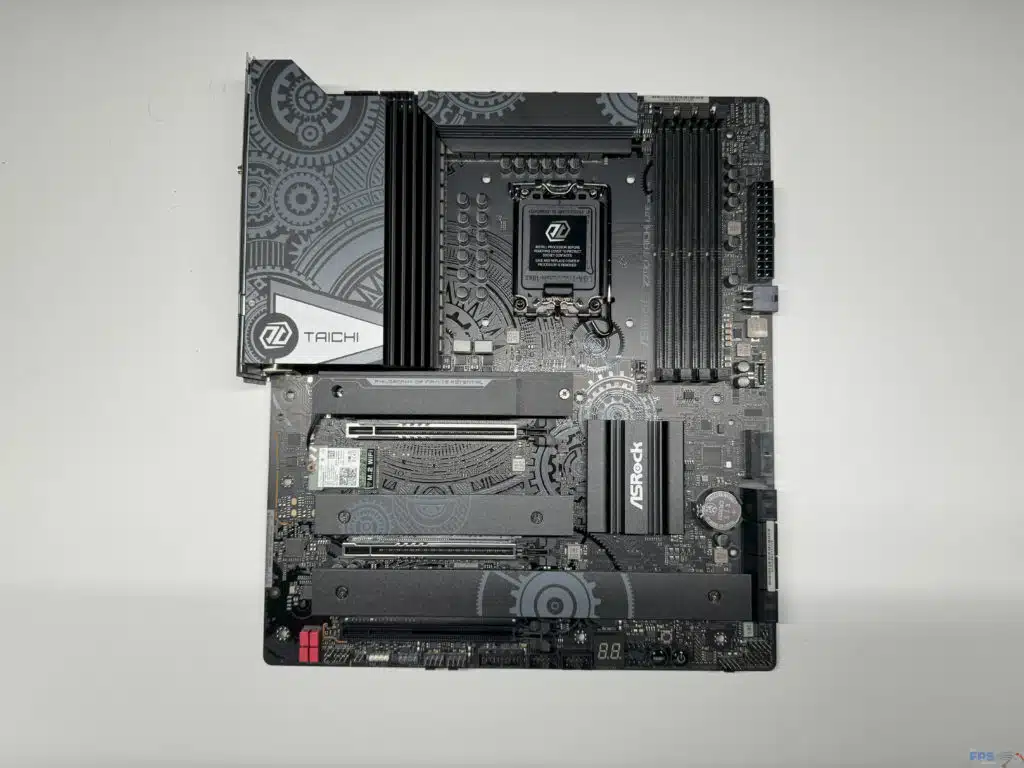
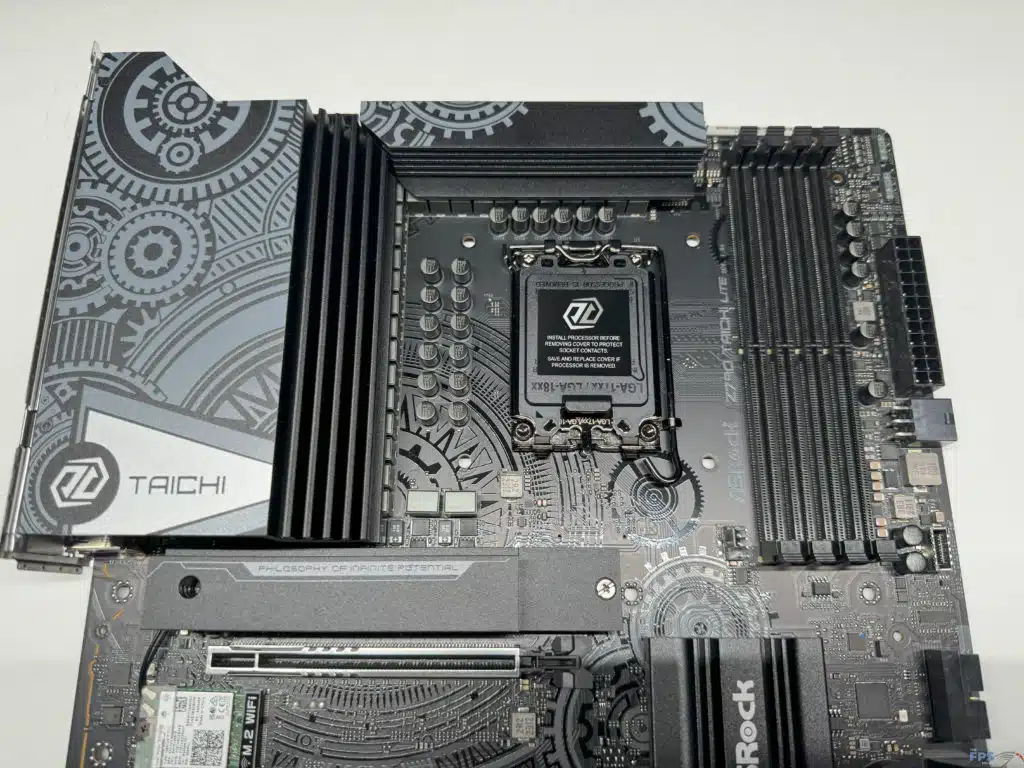

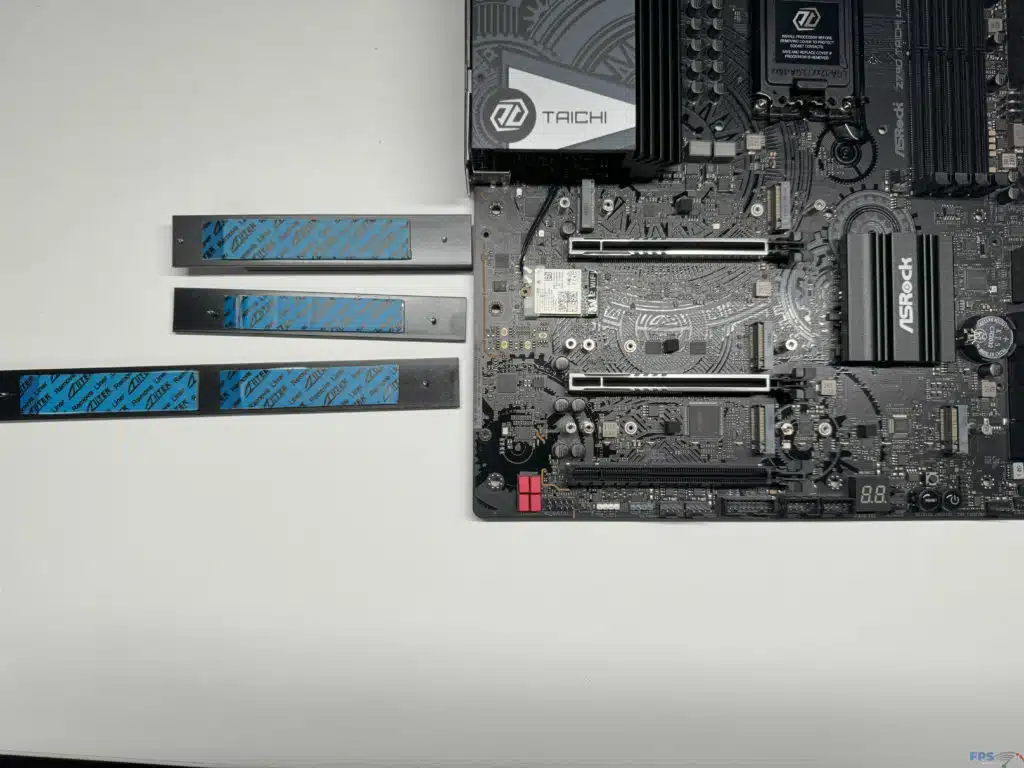
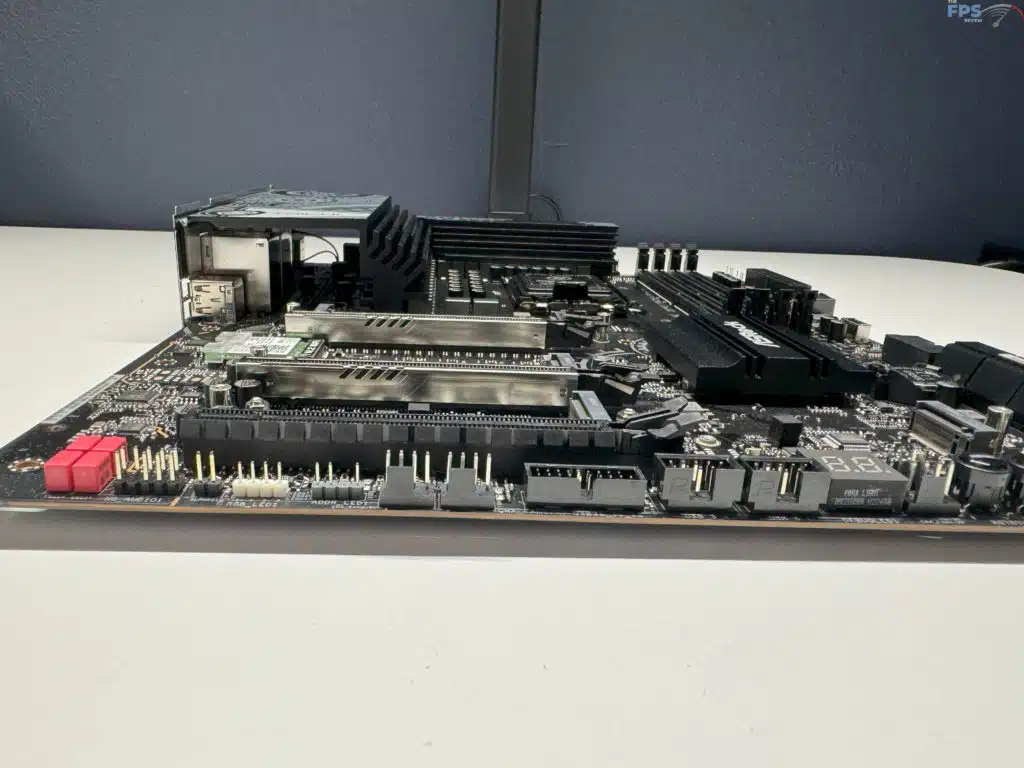

BIOS
The ASRock Z790 Taichi Lite features a single 128 Mb American Megatrends Inc. (AMI) UEFI BIOS with GUI support, which is very similar to any GUI-based BIOS you will find on the market. Prior to testing, we made sure to upgrade our BIOS to the latest stable version, 4.08 released on January 03, 2024.
It is worth noting that this is the first motherboard in a long time that we have had issues with upgrading the BIOS. It was on version 1.06, the release BIOS, and when trying to go straight to version 4.08 as we typically would do, it ran into significant boot issues and we had to get it into a recovery mode of sorts to get back into the BIOS. In the end, we ended up taking the safe approach and upgrading version by version, we are unsure as to why this occurred for us, potentially it was due to starting with a 14th generation CPU, while the updated Microcode was provided in the 2.09 BIOS update.
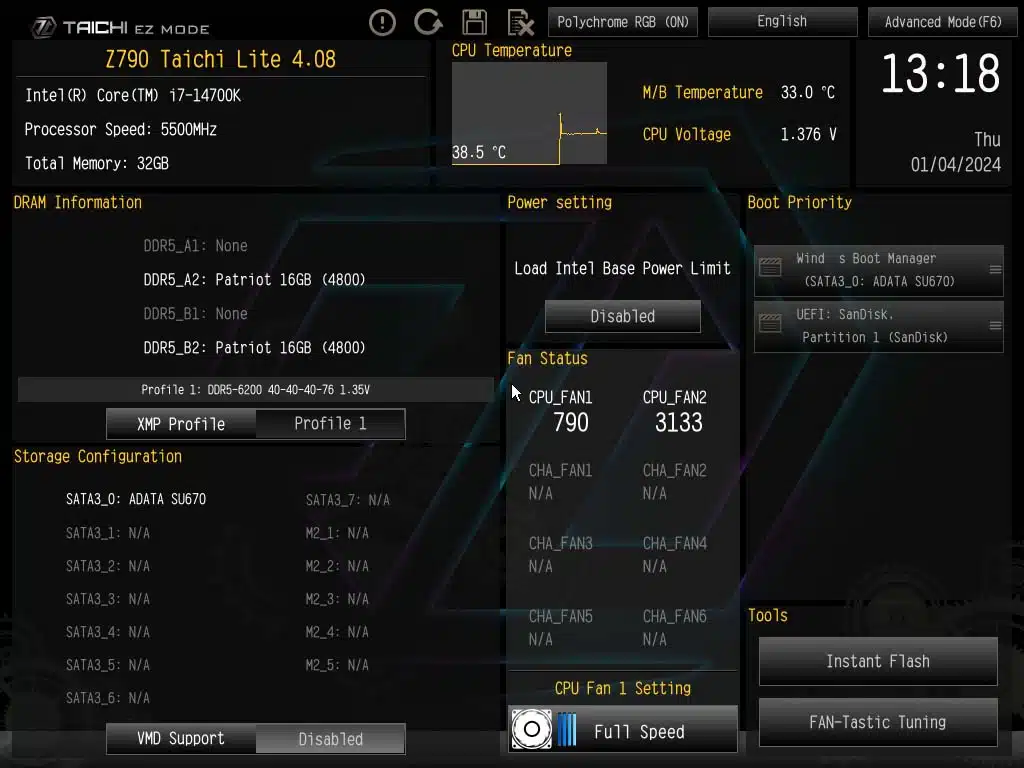
For those of you who are familiar with other ASRock motherboards, or have seen some of our recent reviews of ASRock products, you will have an instant familiarity with this UEFI BIOS. This BIOS was set up very similarly to all of the other recent Z790 motherboards we have reviewed. Looking around the BIOS we had no issues finding any features or options that we might want to tweak or review.
Like most other motherboards, this one defaults to an “EZ Mode”, that can easily be swapped to “Advanced” by hitting “F6”. We will be only focusing on a few features of the BIOS in this review, as this BIOS has very little unique features compared to other AMI BIOSs. At the bottom of this section, we have provided a full gallery to show most of the major options pages available for adjustment in the BIOS. Additionally, ASRock has included an RGB control built into the BIOS to allow for easy control, it is referred to as “POLYCHROME RGB”.
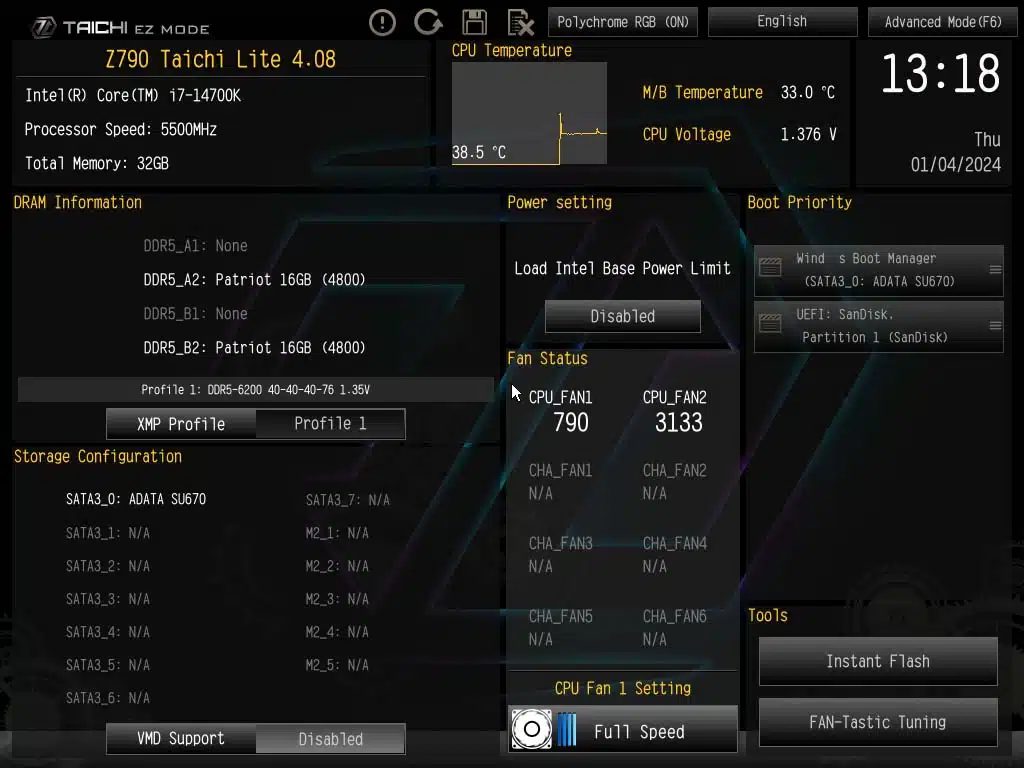
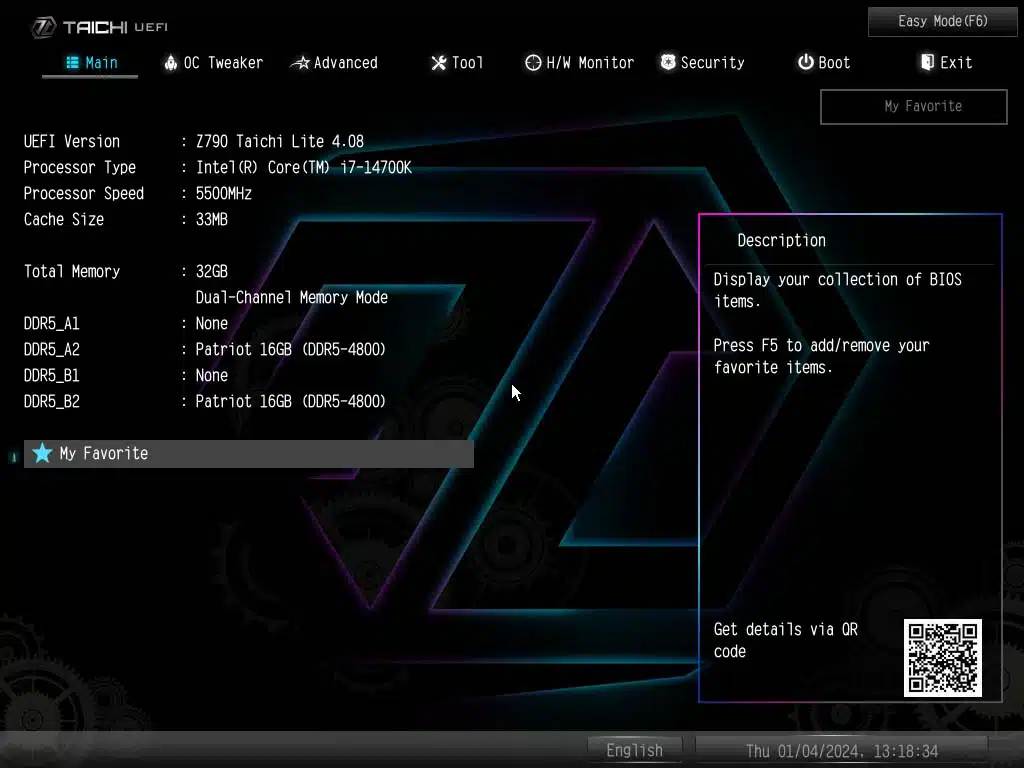
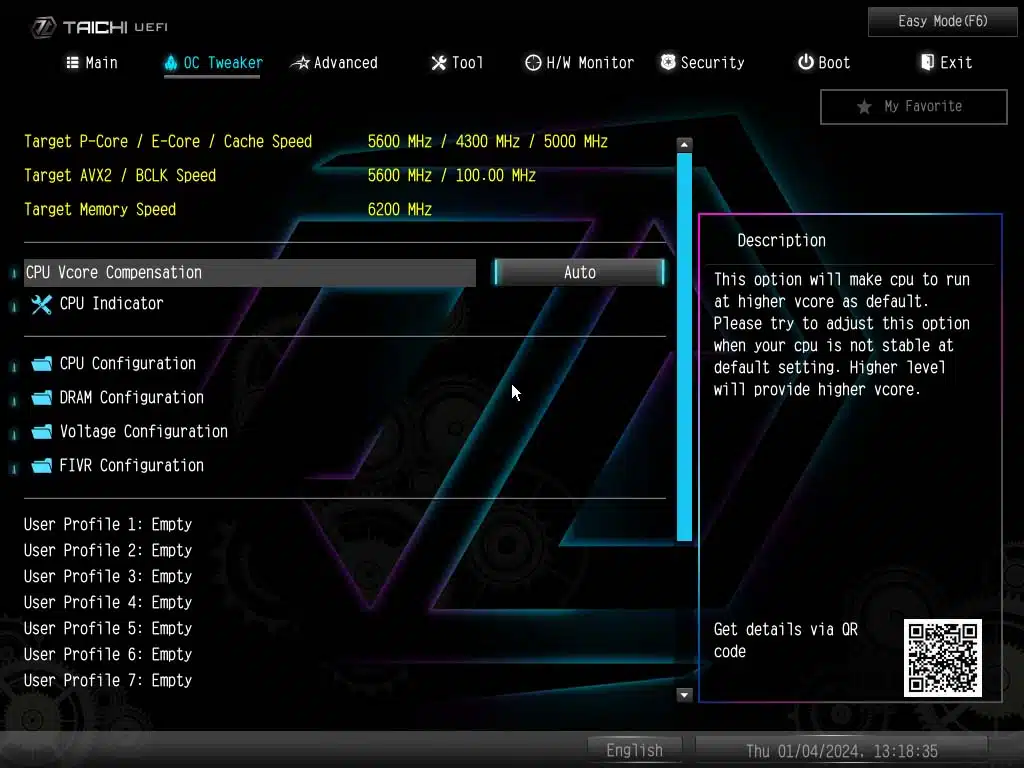


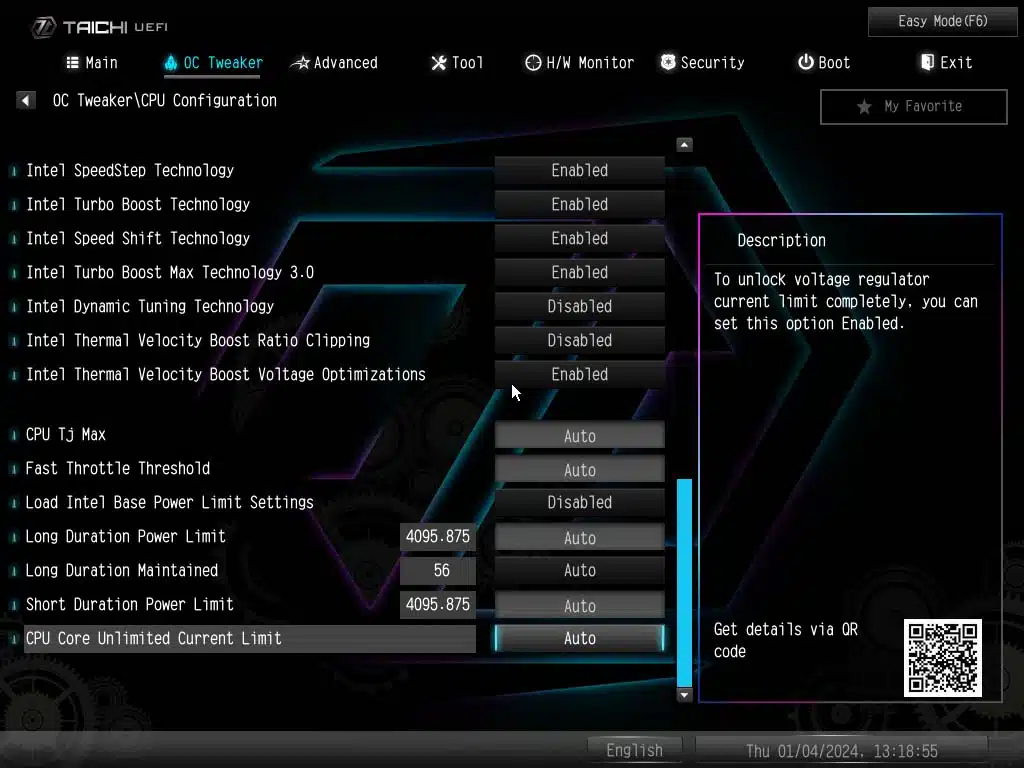
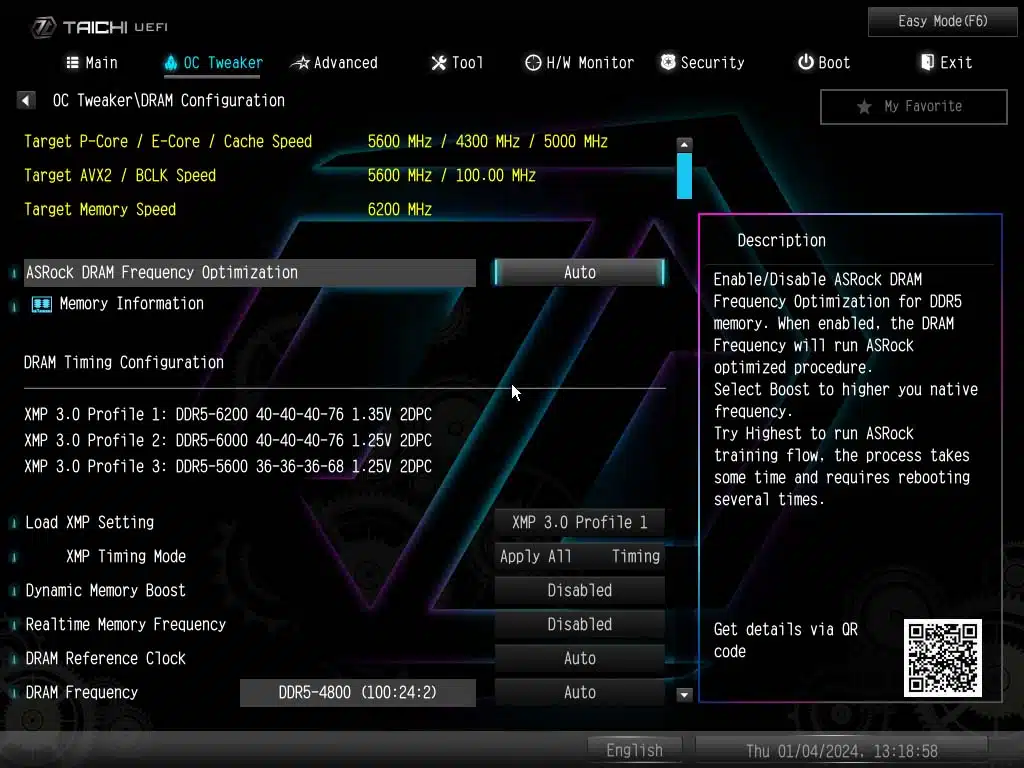
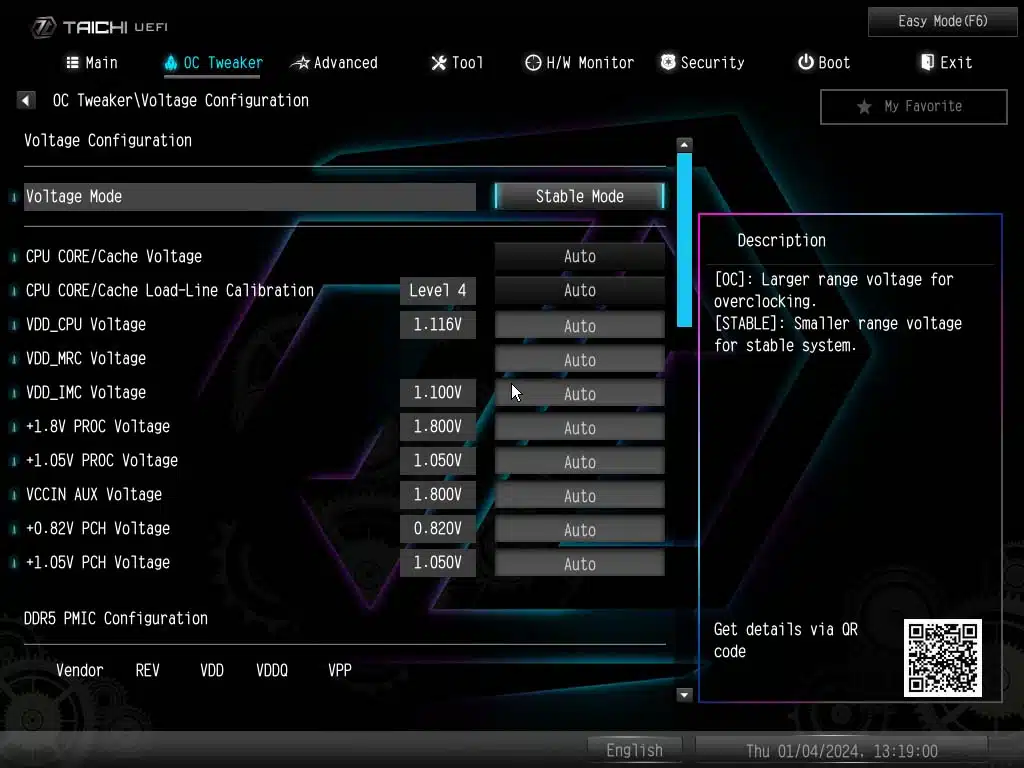

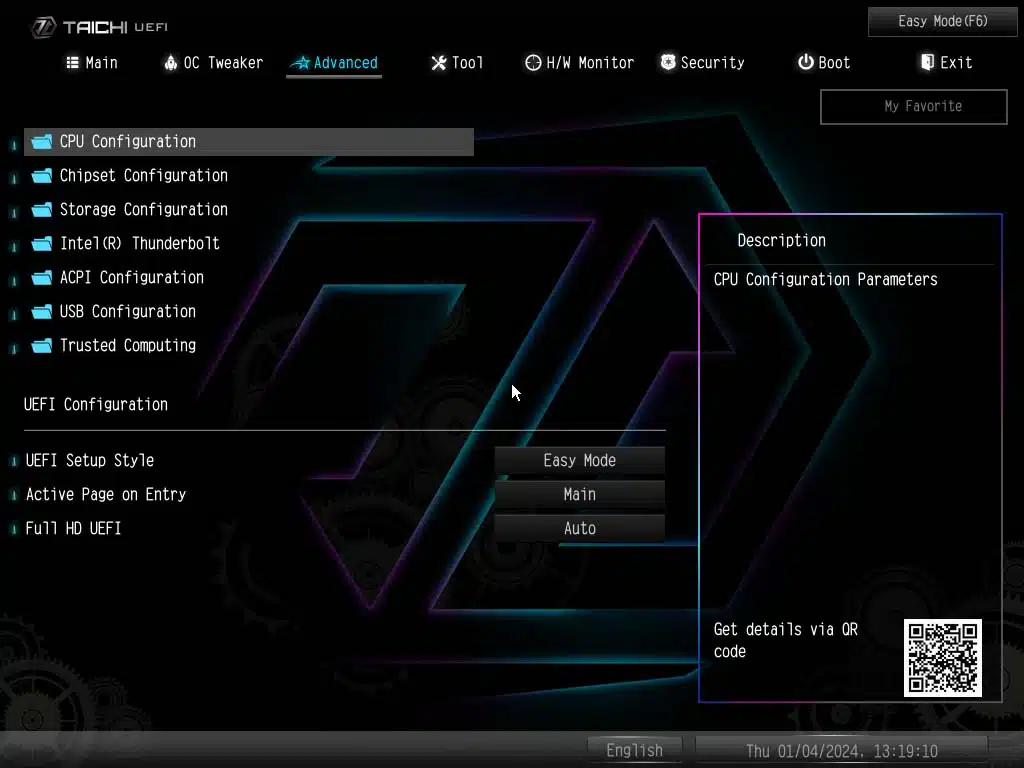
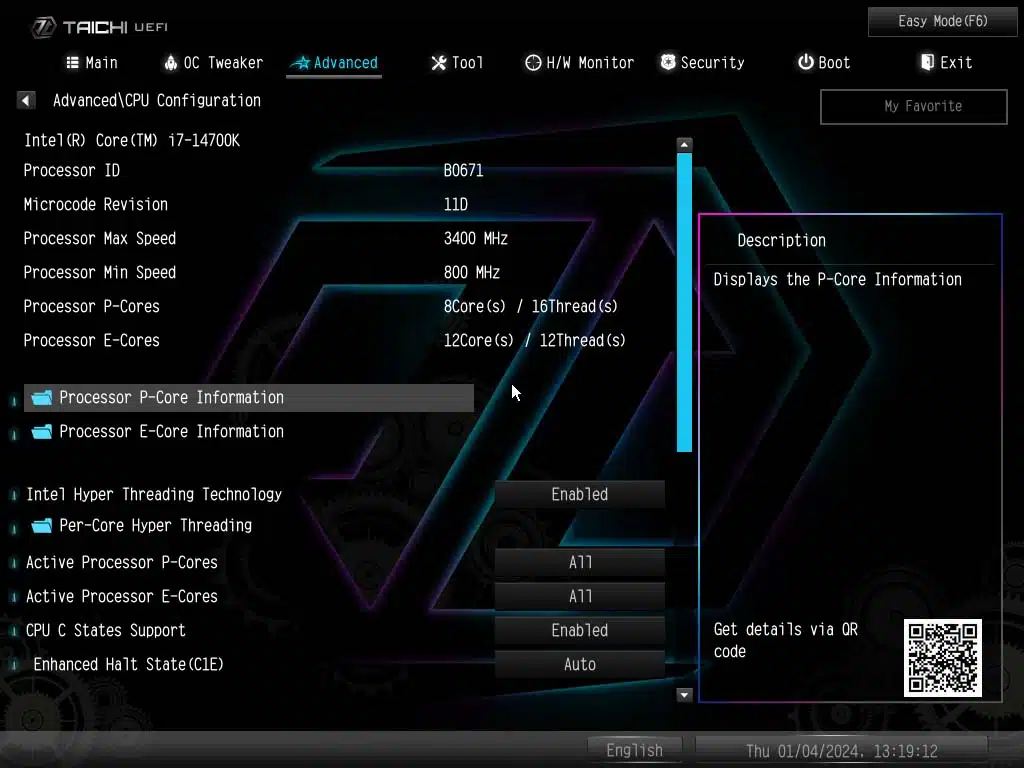

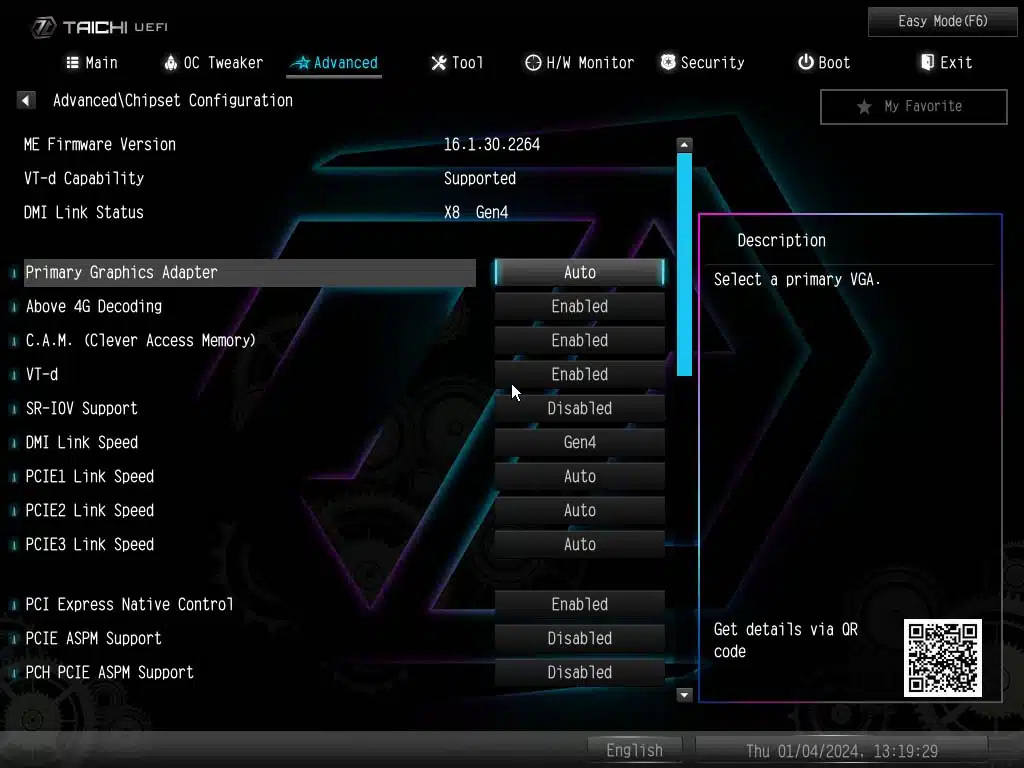
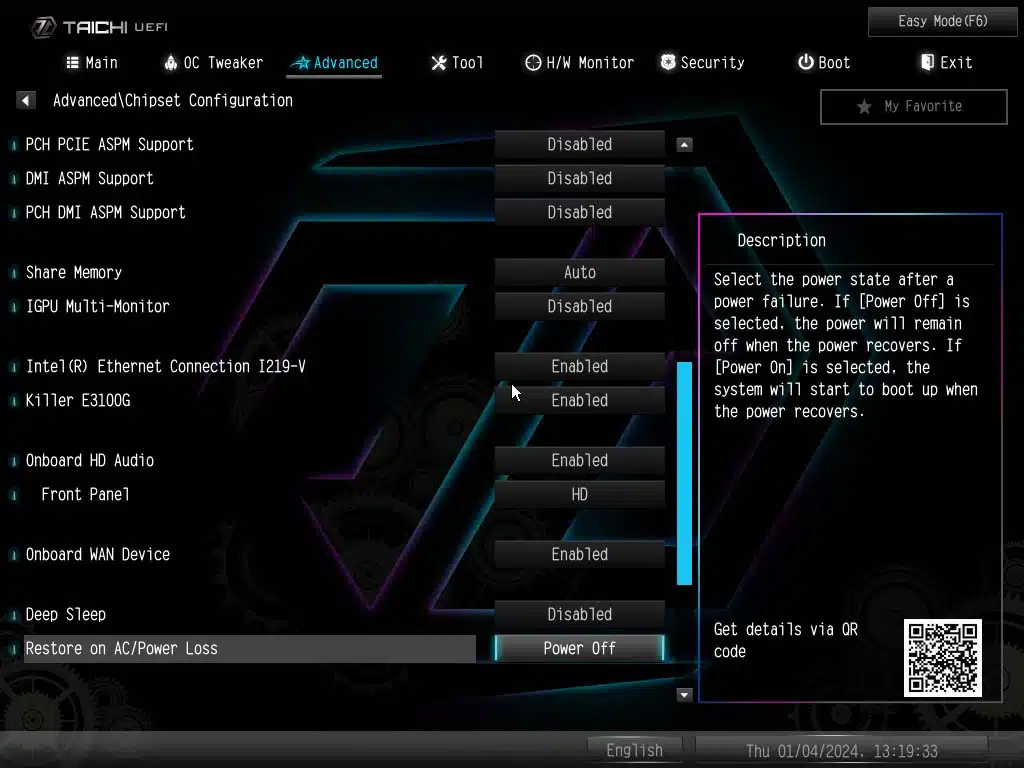





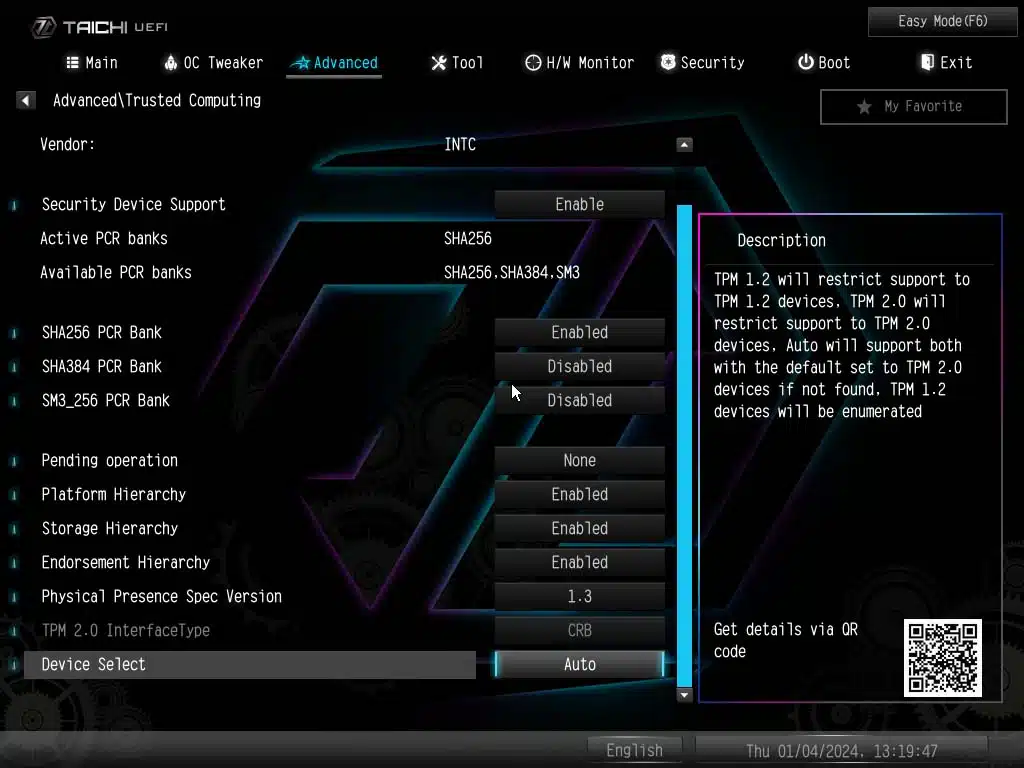

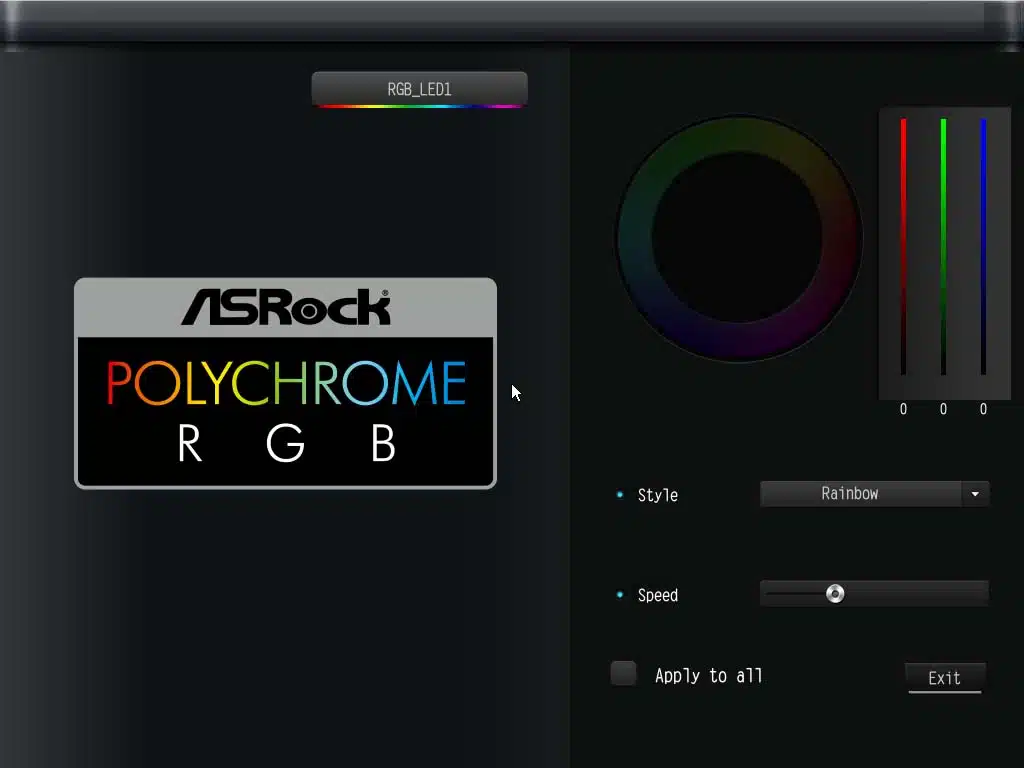

Test Setup
We have the latest BIOS installed, 4.08, released on January 03, 2024. All of our testing was performed at the default settings from the BIOS with the exception of the memory, here we set the DRAM to the XMP-1 profile for full speed on our memory.
For the OS setup note that we are on the latest 23H2 Windows 11 update with all incremental Windows updates applied at the time of writing.
As with other motherboards we have recently tested, we are providing the test results below to give an idea of what a user can expect in a pure stock installation. While the option for factory overclocking was available, we only tested the motherboard with a base configuration. With testing you will notice the lack of a Latency Mon test, a staple of our reviews, this is due to all attempts to test providing false high readings.
Subsystem Testing
SSD Performance
For this motherboard, we tested all five (5) slots, and performance is right in line with expected. All of our M.2 slot testing was performed with our PCIe 5.0 test device, the ADATA LEGEND 970 2TB NVME SSE. In our testing with this motherboard, we see speeds right in line with what we have come to expect. For the lone Gen5 slot, we are able to achieve 10,082.51 MB/s read, and 10,204.98 MB/s write speeds, very similar to the other Z790 motherboards we have tested this ADATA drive on. For all of the Gen4 slots, we saw right around 7,150 MB/s Read, and 7,000 MB/s write speeds, which are essentially the maximum Gen4 speeds you can achieve. Take a look at our gallery for a full listing of the speeds we experienced.

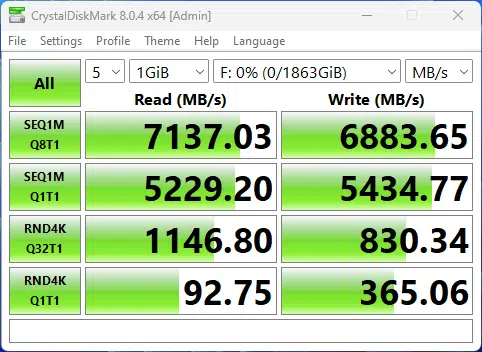
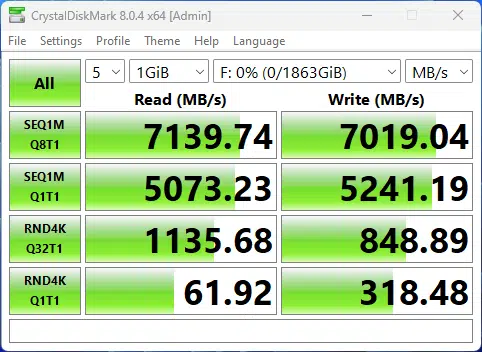


Application Benchmarks
Memory Bandwidth
For our application benchmarks, we are going to start with Aida64, and its memory read and write performance test. At the default settings, with the memory set to 6200MHz, the read performance on this motherboard is 96,518 MB/s of bandwidth, with the write performance coming in at 84,505 MB/s, both of which are some of the highest values we have seen with this memory kit.
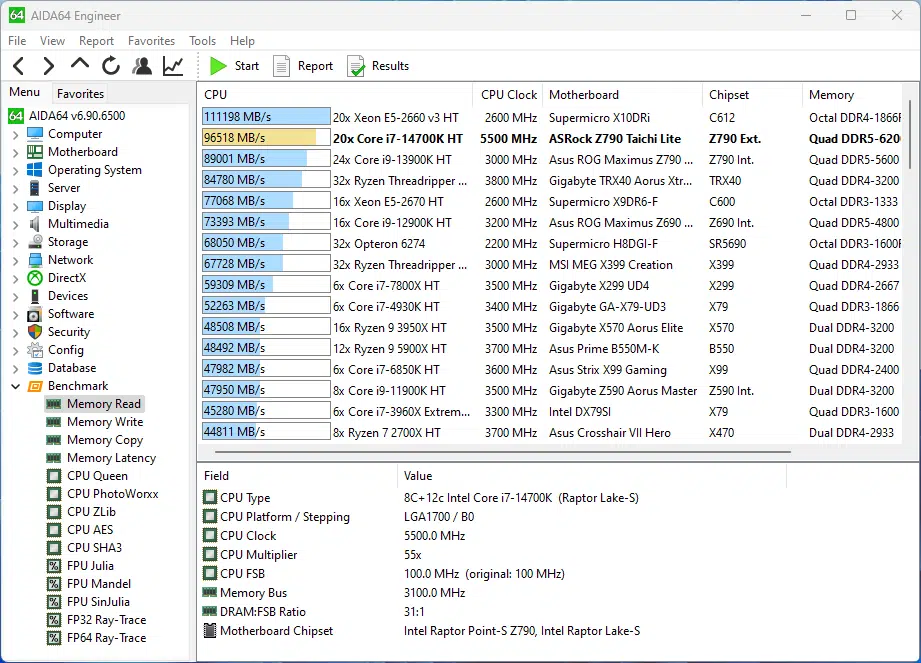

PCMark 10
The standard PCMark 10 test result that we were able to achieve is 9,070, which actually exceeds the score we saw with this processor in our initial test, Intel Core i7-14700K CPU Review – Page 3 of 8 (thefpsreview.com).

Cinebench R23
With Cinebench we ran the multi-core test multiple times and consistently received a score of around 32,777.
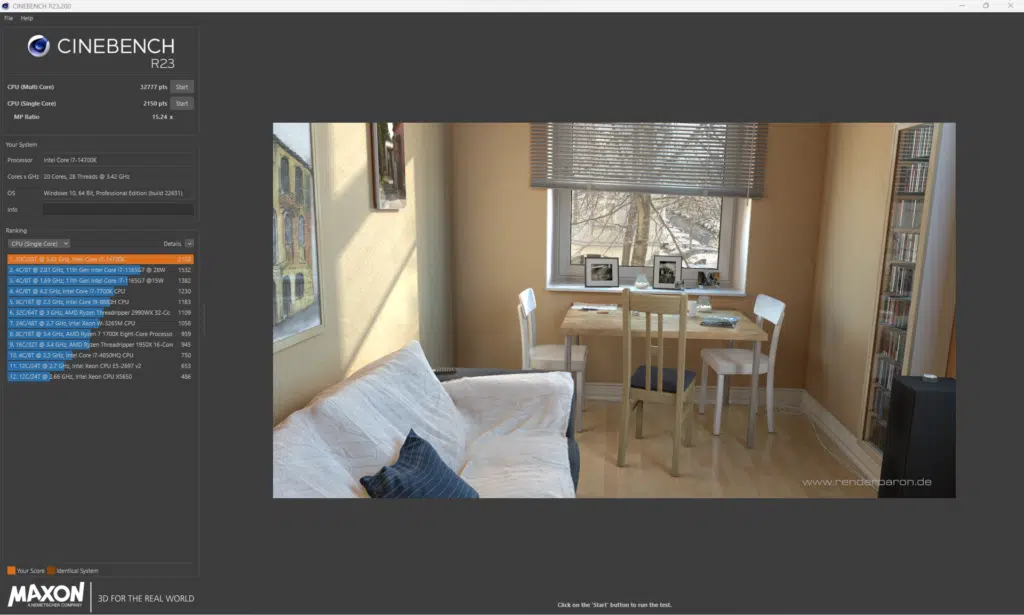
Blender Benchmark
With Blender, we were able to achieve 210.53 samples per minute for the monster test, 140.47 for junkshop, and 104.05 for the classroom tests.
3DMark
We ran both Time Spy and the CPU Profile tests with 3DMark. With the Time Spy test, we achieved a CPU score of 23,013, and for the CPU profile on max threads, we achieved 15,051.

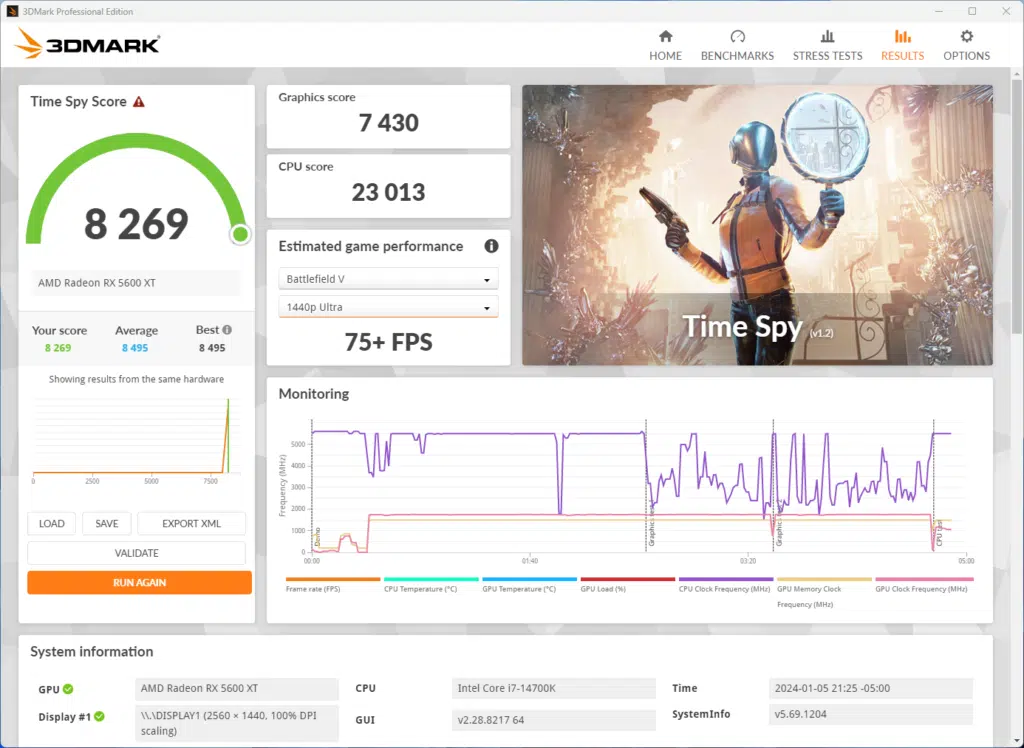
V-Ray Benchmark
Running V-Ray we achieved a score of 23,072, which is about what we would expect.
Conclusion
Today we are wrapping up our testing of the ASRock Z790 Taichi Lite, which is a lower top-tier Z790 offering from ASRock currently selling for $349 on NewEgg. With this being a higher-end motherboard on pricing there are plenty of features that you expect to see, along with some that we have not run across yet. All of the M.2 slots have cooling provided by the motherboard available, tons of storage options with the four (4) total usable M.2 slots, and eight (8) SATA ports. And although we had issues with the BIOS upgrades initially, once we got off of the initial BIOS we had a very stable motherboard that was able to go through our tests with no issues.
Installation and Use
This motherboard was as easy to install as any motherboard we have run across, assuming you can fit the EATX form factor you will be pleased with the locations of all the fan and power connectors, as well as the M.2 cooling being easy to remove as required. Really the only issue we ran into was the BIOS upgrade issues we noted previously.
Final Points
With today’s testing being centered on the ASRock Z790 Taichi Lite, we were able to put it through our full testing cycle, which was passed with no issues. During all tests, we had no stability concerns, or temperature concerns at all, and while the results were all in the ballpark of what we expect on the Z790 platform, we cannot help but feel it was lacking in some corners as it routinely was scoring near the bottom of the Z790 motherboards we have tested.
All of the devices worked out of the box on this motherboard, thanks heavily to ASRock including the essential drivers in their BIOS, our RAM had no issues hitting the rated speed of 6200 MHz, and we were able to max out the Gen5 M.2 drive we use for testing.
The ASRock Z790 Taichi Lite has tons of features, with its 2.5 GbE LAN, its second LAN port, WiFi out of the box, several USB-C type connectors, and up to four (4) M.2 slots, leaving us with quite good motherboard we have here.

